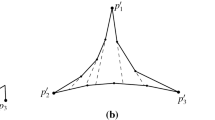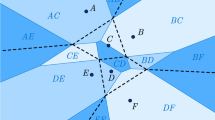Abstract
We revisit a new type of Voronoi diagram, in which distance is measured from a point to a pair of points. We consider a few more such distance functions, based on geometric primitives, namely, circles and triangles, and analyze the structure and complexity of the nearest- and furthest-neighbor 2-site Voronoi diagrams of a point set in the plane with respect to these distance functions. In addition, we bring to notice that 2-point site Voronoi diagrams can be alternatively interpreted as 1-site Voronoi diagrams of segments, and thus, our results also enhance the knowledge on the latter.
Similar content being viewed by others
References
Aurenhammer F (1991) Voronoi diagram — A survey of a fundamental geometric data structure. ACM Computing Surveys 23(3):345–405
Okabe A, Boots A, Sugihara B, Chui S N. Spatial Tesselations: Concepts and Applications of Voronoi Diagrams (2nd edition). John Wiley and Sons, Inc., 2000.
GavrilovaML E. Generalized Voronoi Diagram: A Geometry-Based Approach to Computational Intelligence. Springer Publishing Company, 2008.
Barequet G, Dickerson M, Drysdale III R L S. 2-point site Voronoi diagrams. In Proc. the 6th International Workshop on Algorithms and Data Structures, Aug. 1999, pp.219–230.
Roth KF (1951) On a problem of Heilbronn. Proc London Mathematical Society 26:198–204
Vyatkina K, Barequet G. On 2-site Voronoi diagrams under arithmetic combinations of point-to-point distances. In Proc. the 7th Int. Symp. Voronoi Diagrams in Science and Engineering, June 2010, pp.33–41.
Dickerson M T, Eppstein D. Animating a continuous family of two-site Voronoi diagrams (and a proof of a bound on the number of regions). In Proc. the 25th Annual Symposium on Computational Geometry, June 2009, pp.92–93.
Hanniel I, Barequet G. On the triangle-perimeter two-site Voronoi diagram. In Proc. the 6th Int. Symp. Voronoi Diagrams, June 2009, pp.129–136.
Hodorkovsky D. 2-point site Voronoi diagrams [M.Sc. Thesis]. Technion-Israel Inst. of Technology, Haifa, Israel, 2005.
Asano T, Tamaki H, Katoh N, Tokuyama T. Angular Voronoi diagram with applications. In Proc. the 3rd Int. Symp. Voronoi Diagrams in Science and Engineering, July 2006, pp.18–24.
Asano T, Katoh N, Tamaki H, Tokuyama T. Voronoi diagrams with respect to criteria on vision information. In Proc. the 4th Int. Symp. Voronoi Diagrams in Science and Engineering, July 2007, pp.25–32.
Sharir M, Agarwal P K. Davenport-Schinzel Sequences and Their Geometric Application. Cambridge University Press, 1995.
de Berg M, Cheong O, van Kreveld M, Overmars M. Computational Geometry, Algorithms, and Applications (3rd edition). Springer-Verlag, Berlin TELOS, 2008.
Ajtai M, Chvátal V, Newborn M, Szemerédi E (1982) Crossing-free subgraphs. Theory and Practice of Combinatorics North-Holland Mathematics Studies 60:9–12
Leighton F (1983) Complexity Issues in VLSI. MIT Press, Cambridge, MA
Author information
Authors and Affiliations
Corresponding author
Additional information
David Eppstein was supported by National Science Foundation of USA under Grants Nos. 0830403 and 1217322 and US Office of Naval Research under Grant No. N00014-08-1-1015.
Electronic Supplementary Material
Below is the link to the electronic supplementary material.
Rights and permissions
About this article
Cite this article
Barequet, G., Dickerson, M., Eppstein, D. et al. On 2-Site Voronoi Diagrams Under Geometric Distance Functions. J. Comput. Sci. Technol. 28, 267–277 (2013). https://doi.org/10.1007/s11390-013-1328-2
Received:
Revised:
Published:
Issue Date:
DOI: https://doi.org/10.1007/s11390-013-1328-2




